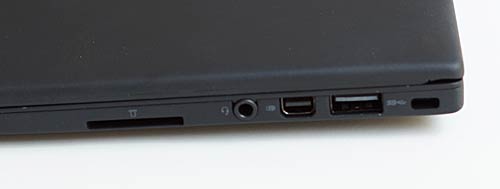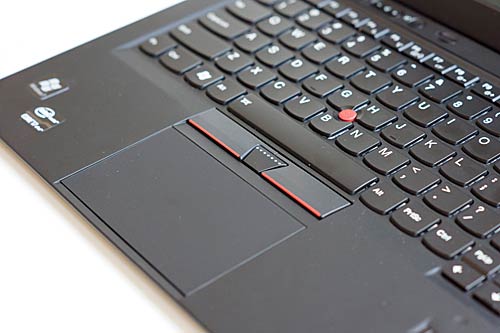Lenovo Thinkpad X1 Carbon
11:45
There are laptops, and then there are ThinkPads.
Robust notebooks with a soft touch raven black finish and the best
keyboard in the business. So when Lenovo releases a ThinkPad Ultrabook,
we take notice. The ThinkPad X1 Carbon is Lenovo's first official
ThinkPad Ultrabook. Yes, they released the original ThinkPad X1
in May of 2011, but it weighed nearly 4 pounds, had full mobile rather
than ULV CPUs and didn't go by the then nonexistent Ultrabook handle.

The Lenovo ThinkPad X1 Carbon is both
thoroughly Ultrabook and ThinkPad. It has the unmistakable look of a
ThinkPad and that mil spec solidness that says "go ahead, drop me a few
times". It runs on Intel Ivy Bridge ULV CPUs (your choice of Core i5 and
Core i7) with Intel HD 4000 graphics and it weighs just 3 pounds.
Unlike the small but powerful 12.5" Lenovo ThinkPad X230,
the X1 Carbon is one of the thinner machines on the planet at 0.31-0.71
inches. It has dual band WiFi, Bluetooth 4.0, a 3G SIM card slot and a
720p webcam.
The ThinkPad Carbon X1 starts at $1,399
for the base 1.7 GHz Core i5-3317U with a 128 gig SSD. The Core i7
2.0GHz with VPro and a 256 gig SSD is $1,849. There are a few
configurations in between, and all start with 4 gigs of DDR3 RAM (8 gigs
is max). But don't lose heart: Lenovo often has aggressive sales that
save you 10 percent or more.
Hello High Res Display
The ThinkPad X1 Carbon is a 14" laptop
with a 13.3" footprint. It has a 1600 x 900 display with wide viewing
angles and 300 nits of brightness. And it's a matte display, goodbye
glare! Lenovo addresses two complaints with the outgoing X1: no high res
option and no matte option since it was clad in durable but mirror-like
Gorilla Glass. Though the X1 Carbon's display can't compete with Asus
Zenbook Prime 1080p IPS matte displays, it's one of the better non-IPS
displays found on notebooks. It has fairly wide viewing angles, a very
large horizontal sweet spot for optimal viewing and good (though not
great) colors. The display has a slight blue tint and warmer tones like
oranges and reds don't pop as they do on the IPS version of the X230.
Still, we'd opt for the 14" X1 Carbon vs. 12.5" X230 display for both
size and resolution.

Design and Ports
The X1 Carbon has a carbon rather than
magnesium alloy roll cage inside (hence the name) and it's passed 8
Mil-Spec tests for cold, heat, dust, humidity, altitude and vibration.
The shell is also carbon fiber, and as we've learned from high end Sony
Vaio notebooks, this allows for a much lighter product. The X1 Carbon
has one USB 2.0 port and one USB 3.0 port. It has a mini DisplayPort and
a 3.5mm audio jack. Lenovo, like Asus, included a USB 10/100 Ethernet
adapter in the box. We're honestly surprised Lenovo didn't fit a few
more ports in this 14" chassis.
There's no HDMI port, but you can buy a
mini Display Port to HDMI adapter for $20 to $30. Likewise there are VGA
adapters on the market for those who use legacy projectors and older
monitors. Thus the DisplayPort is very versatile and it can drive very
high resolution displays that exceed 1920 x 1200, unlike many
HDMI-equipped laptops. The notebook has small stereo speakers and Dolby
Home Theater v4 audio that produces good volume but somewhat harsh and
thin sound through the built-in speakers. Headphone audio is much more
pleasing and full.

There are two camps of people: ThinkPad
people and those who think that ThinkPads look dull and chunky. Even if
you're in the latter category, you'll likely think this is one cool
looking notebook. It's murderously thin and not deadly dull. It's no Mac
clone and it stands out from the horde of silver Ultrabooks. It's sleek
yet sturdy looking and the surface is a pleasure to touch. It also
cleans easily: a damp cloth removes fingerprint oils from the matte
surface. It's also the most rugged Ultrabook on the market (excluding
products from companies that specialize in rugged products for verticals
and the military). Like all ThinkPads, drops and bumps rarely result in
damage.
With the X1 to X1 Carbon size reduction,
we lost the dock connector and battery sheet option. Both are common
Lenovo ThinkPad features, and I know some of you are disappointed and
might even have to pass on this otherwise lovely machine because there's
no way to extend runtimes in the field with a sheet battery and the
main battery is sealed inside.
Keyboard and UltraNav
Like the Lenovo ThinkPad X230, the X1
Carbon has Lenovo's recently revised 6 row keyboard design, and we like
it. Ancient keys like SysRq have been banished, and the PrtSc (print
screen) key is now at the lower right rather than at the top row. The
delete key is at the top right corner where it belongs, just above the
oversized backspace key. The roomy Chiclet style keyboard has oversized
enter, shift and left control keys. Key travel and tactile feel are
superb for such a thin machine. Sculpted keys that aren't too slick or
too sticky round out an excellent typing experience. The X1 Carbon and
Dell XPS 13 have the best keyboards among Ultrabooks, and we put the
ThinkPad at the top.
The keyboard has backlighting: press the
Fn and spacebar to toggle two levels of white backlight. Sorry, there's
no ThinkLight LED lamp above the display to shine down on the keyboard.
Typical of Lenovo, There are dedicated mute and volume buttons above
the keyboard along with the ThinkVantage button for assistance and
system recovery. The illuminated power button lives at the upper right
just above the Fn row and a wireless indicator is beside it. The X1
Carbon has a wireless control slider on the left side.
The UltraNav combined trackpad and
TrackPoint is made by Synaptics and they work very well. The trackpad is
roomy (37% larger than the original X1's) and responsive for
multi-touch, and is optimized for Windows 8 according to Lenovo. The
TrackPoint, for those who grew up with IBM's eraser stick pointer, is
there in all its glory. The TrackPoint has traditional buttons while the
trackpad is the trendy buttonless glass affair. The trackpad gives a
pleasing audible and tactile click when you left and right click.
Performance
Unlike the first X1 that employed full
mobile CPUs, this is through and through an Ultrabook with ULV (ultra
low voltage) CPUs that use less power and generate less heat than full
mobile CPUs. Something has to give, and that's performance. While ULV
Core i5 and i7 CPUs are more than adequate for productivity and
streaming media playback, don't expect them to handle 1080p video
production or 4,000 rows of Excel spreadsheet computation like their
full mobile brethren.
But for those of us who use
ultraportables to get everyday work done on the road, video chat on
Skype, social network and kill time watching YouTube and Netflix, the
ThinkPad X1 Carbon is all that. With third generation Intel Ivy Bridge
CPUs and Intel HD 4000 graphics, the ThinkPad X1 Carbon is your
productivity buddy. Lenovo sent us their fastest configuration with a
2.0GHz dual core Intel i7-3667U (Turbo Boost to 3.2 GHz) 4 gigs of DDR3
1333MHz RAM and a SanDisk X100 SSD drive. Our machine benchmarked at
the top of the Ultrabook heap on PCMark Vantage, thanks to Lenovo's
solid internals and the faster than usual CPU (most Ultrabooks ship with
either a 1.7 GHz Core i5 or a 1.9 GHz Core i7). In 3DMark Vantage, the
score was average among Ultrabooks with Intel HD 4000 graphics. Since
this is a business oriented machine, Lenovo didn't squeeze out extra 3D
performance as Toshiba did with their widescreen Toshiba Satellite U845W that's oriented toward multimedia and light gaming.
Wireless Options
The machine ships with Intel Centrino
Advanced-N 6205 dual band WiFi 802.11a/b/g/n with vPro. It supports WiFi
Direct connections but there's no WiDi software for wireless display.
The notebook has ThinkPad (Broadcom) Bluetooth 4.0 and an unlocked
Ericsson H5321 GSM 3G SIM card slot (3G on the 850/900/1900/2100MHz
bands, ideal for AT&T in the US and any GSM carrier overseas). The
laptop can act as a mobile hotspot and rebroadcast its WiFi or 3G
connection over WiFi to serve your smartphone, other notebook or tablet.
Battery Life
The Lenovo ThinkPad X1 Carbon has a 45Wh
Lithium Ion battery that's sealed inside. As mentioned, there's no
external battery slice option to extend runtimes. As a consolation, the
machine uses Lenovo's RapidCharge that can charge to 80% in 35 minutes. A
full charge takes 1.5 hours and a 90% charge just 45 minutes.
Excellent. Lenovo claims up to 6.3 hours on a charge, and in our tests
over the course of a week, we averaged 5.4 hours with display brightness
set to 50% and WiFi turned on in a mix of productivity and light
multimedia tasks. That's at the low end of average for Ultrabooks.
You know that standard Lenovo charger
with a barrel tip? Toss it in the trash or sell it on Craigslist. The X1
Carbon uses a new rectangular connector. The charger isn't among the
smallest and lightest we've seen with Ultrabooks, but the high output
90w, 20v brick does charge the laptop extremely quickly.



0 comments